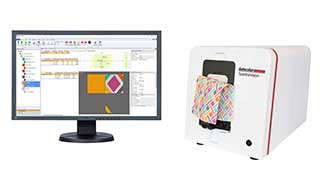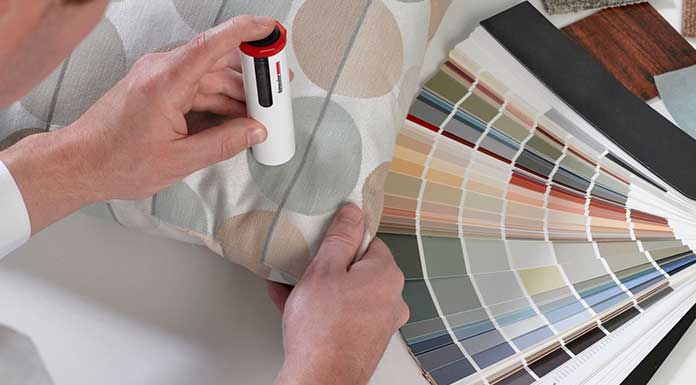
Consistent color is a key quality indicator for the textile industry, and the only reliable way to evaluate color is with color measurement. In this blog, I’ll review some best practices for textile sample measurement.
Textile sample measurement technique
A “measurement technique” describes how a sample will be measured on a spectrophotometer to ensure that the results are accurate and repeatable. Ideally, a repeatable measurement technique has been defined when a sample can be measured, removed from the instrument, and then remeasured with a variation of less than 0.15 DE(CMC) units. Anything larger will lead to unreliable decisions regarding sample quality.
Here are some factors that can affect the repeatability of textile sample measurement:
Sample Size
For most measurements the sample will be folded to multiple layers. This means the sample should be large enough that when folded it will still cover the measurement aperture of the spectrophotometer. Samples that are smaller than 3” x 3” (7.5cm x 7.5cm) can be difficult to fold and measure repeatably.
Thickness
If a sample is not opaque, light will pass through the sample during measurement and reflect off the backing material or sample holder, producing misleading reflectance data. For most knitted and woven fabrics, two to four layers of material are sufficient to ensure opacity.
Lightweight and translucent materials may not be opaque even at four layers, but using more layers would force the material into the interior of the instrument. Instead, measure only a few layers of material backed with a white ceramic tile like the instrument’s calibration tile. Samples measured with identical white tile backings can still be compared numerically since the contribution of the backing is the same.
Positioning
Measurements can vary depending on the fabric construction or due to unlevel dyeing. To help account for this, remove the sample from the instrument and refold or reposition it before additional readings. Simply rotating the sample between measurements without repositioning will not produce repeatable results.
It is also critical when measuring to avoid any areas of the sample that are contaminated by dirt, fingerprints, creases, dye blotches, or other substances.
Number of measurements
Here’s a technique to determine the number of measurements required to ensure accurate data:
Measure a sample eight times—rotating and repositioning—and save the average.
- Remeasure the sample seven times, using the same technique.
- Continue remeasuring fewer times down to two reads.
- Review the color difference data between each test and the original sample, and identify the point at which the DE(CMC) exceeds the desired 0.15 limit. This indicates the correct number of reads for accurate sampling.
- Finally, measure the sample at least four more times using the identified number of reads, and ensure that in each case the variation does not exceed 0.15.
Although time consuming initially, this process will ensure accurate data and more consistent color quality decisions.
Sample Types
It may be necessary to develop different measurement techniques according to the sample type, whether fabric, fiber, or yarn.
Fabric
Flat woven and knit fabric samples are the easiest to measure repeatably because of their uniform construction. As indicated previously, thickness can be an issue with sheer fabrics and it may be necessary to measure with a white tile backing.
Similarly, bulky fabrics or those with a pile require special handling. They should be measured behind a glass plate, and the spectrophotometer configured to measure in specular excluded mode to remove reflectance due to the glass. Special sample holders can also be used that prevent the pile yarns from protruding into the sphere.
Loose Fiber
It can also be difficult to measure loose fiber repeatably. Loose fibers can protrude into the spectrophotometer and lead to measurement errors, so measurement behind a glass plate or with a glass compression cell is usually required.
To improve repeatability for compression cell measurements, place an exact mass of fiber into the compression cell and apply a constant amount of pressure. This will eliminate errors due to gaps between fibers.
Yarn
Yarn can be measured accurately by first winding it around a card or tab. To prevent measurement errors, yarn tension must be controlled from sample to sample.
Specially designed spring devices can also be used to clamp a yarn skein securely to a plate. Ideally, individual yarns in a skein must be aligned to prevent shadows that the instrument would detect as differences in depth of shade. The skein must also be thick enough to prevent light from passing through the strands and reflecting off the background.
Knitted Sleeves
Knitted sleeves are often used to evaluate color quality in package dyeing. Uniform construction and size make knitted sleeves relatively straightforward to measure using the spectrophotometer’s largest view port.
Knitting the standard and sample into the same sleeve will eliminate the potential variations between samples produced under different conditions; such as on different knitting machines.
Textile sample measurement Tables
While these tables are useful guides, each company should evaluate their own materials using the techniques described here. They must fully test and confirm the repeatability of their procedures; to ensure that poor measurement technique doesn’t introduce errors into instrumental quality control programs.
Written by Ken Butts, Datacolor, Global Key Account Team Manager

